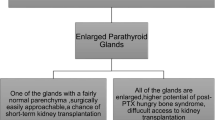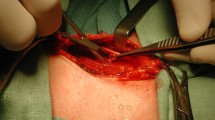Summary
The PTH secretion was studied in fragments of 83 (reactive) hyperplastic parathyroids (type 1a:n=24; type 1b:n=20, type 2:n=39) simulating hypo- (0.3 mmol Ca++=maximal PTH secretion), normo- (0.9 and 1.2 mmol Ca++) and hypercalcemia (3.0 mmol Ca++=basic PTH secretion, maximal suppressibility) in vitro. 56 out of 83 glands (67%) were suppressible (PTH secretion decreased under 50% of maximal secretion) with no significant difference in suppressibility of diffuse and nodular hyperplasia (50% and 74%, respectively). Differentiating diffuse hyperplastic glands in those with (type 1 a) and without (type 1b) stroma fat cells, 92% of type 1a glands and only 25% of type 1b glands were suppressible (Fischer's test:p<0.001). Separated (oxyphilic and/or chief cell) nodules, type 1 b- and type 1 a-like areas (both localized between nodules) of types 2 glands were suppressible in 18%, 17% and 91%, respectively (Fischer's test:p < 0.001). Thus fragments of type 1a regions should be autotransplanted for preference. Type 1b regions or nodules should not be used for grafting.
Zusammenfassung
Gewebefragmente von 83 reaktiv hyperplastischen Nebenschilddrüsen (Typ 1a:n=24; Typ 1b:n=20, Typ 2:n=39) wurden in vitro durch Simulation einer Hypo- (0,3 mmol Ca++=maximale Parathormonsekretion), Normo-(0,9 und 1,2 mmol Ca++) und Hypercalciämie (3,0 mmol Ca++=basale=basale Parathormonsekretion; maximale Suppression) funktionell untersucht. Bei 56 der 83 untersuchten Drüsen (67%) war die Parathormonsekretion unter 50% der maximalen Hormonsekretion supprimierbar, wobei kein signifikanter Unterschied zwischen diffusen und nodulären Hyperplasien festzustellen war (50% versus 74%). Dem unterschiedlichen cytologischen Aufbau des diffus hyperplastischen Drüsentyps entsprachen deutlich unterscheidbare funktionelle Eigenschaften: So waren Typ 1a-Drüsen (Fettzellen zwischen Hauptzellen) signifikant häufiger supprimierbar als Typ 1b-Drüsen (keine Fettzellen! 92% versus 25%; Fischer Test:p<0,001). Die weitere Untersuchung von unterschiedlich zusammengesetzten (= selektierten) Arealen innerhalb der Typ 2-Drüsen erbrachte eine signifikant schlechtere Supprimierbarkeit der Hormonsekretion in oxyphilen und/oder Hauptzellknoten (18%) sowie in zwischen Knoten liegenden Typ 1b-ähnlichen Arealen (17%). Zwischen Knoten liegende Typ 1a-ähnliche Areale waren in 91 % supprimierbar (Fischer Test:p<0,001). Morphologisch unterschiedlich aufgebaute Drüsen oder Drüsenregionen reagieren auch funktionell unterschiedlich. Dieser enge Zusammenhang erlaubt somit aus der Morphologie die Vorhersage des wahrscheinlichen funktionellen Verhaltens. Darum sollten vor allem Typ 1a-Regionen zur Autotransplantation ausgewählt werden. Typ 1b- oder knotige Areale scheinen für eine Autotransplantation ungeeignet.
Similar content being viewed by others
Literatur
Birnbaumer ME, Schneider AB, Palmer D, Hanley DA, Sherwood LM (1977) Secretion of parathyroid hormone by abnormal human parathyroid glands in vitro. J Endocrinol Metab 45:105–113
Brennan MF, Brown EM (1980) Prediction of in vivo function of human parathyroid tissue autografts by in vitro testing. World J Surg 4:747–753
Brown EM, Broadus AE, Brennan MF, Gardner DG, Marx StJ, Spiegel AM, Downs RW, Attic M, Aurbach GD (1979 a) Direct comparison of in vivo and in vitro suppressibility of parathyroid function by calcium in primary hyperparathyroidism. J Clin Endocrinol Metab 48:604–609
Brown EM, Broadus AE, Brennan MF, Gardner DG, Marx StJ, Spiegel AM, Downs RW, Attic M, Aurbach GD (1979b) Human parathyroid autografts: comparison of function in vivo and in vitro. J Clin Endocrinol Metab 48:648–653
Brown EM (1982) PTH secretion in vivo and in vitro. Regulation by calcium and other secretagogues. Mineral Electrolyte Metab 8:130–150
Brown EM, Wilson RE, Eastman RC, Pallotta J, Marynick SP (1982) Abnormal regulation of parathyroid hormone release by calcium in secondary hyperparathyroidism due to chronic renal failure. J Clin Endocrinol Metab 54:172–179
Brown EM (1983) Four-parameter model of the sigmoid relationship between parathyroid hormone release and extracellular calcium concentration in normal and abnormal parathyroid tissue. J Clin Endocrinol Metab 56:572–581
Cantley LK, Ontjes DA, Cooper CW, Thomas CG, Leight GS, Wells SA (1985) Parathyroid hormone secretion from dispersed human hyperthyroid cells: increased secretion in cells from hpyerplastic glands versus adenoma. J Clin Endocrinol Metab 60:1032–1037
Niederle B, Roka R, Brennan MF (1982) The transplantation of parythyroid tissue in man: development, indications, technique and results. Endocrine Rev 3:245–279
Niederle B, Roka R, Hörandner H (1988) ‘Invited commentary’ zu [20]. World J Surg 12:437–438
Niederle B, Hörandner H, Roka R, Woloszczuk W (1988) Parathyreoidektomie und Autotransplantation beim renalen Hyperparathyreoidismus: I. Morphologische Untersuchungen zur Gewebeauswahl. Langenbecks Arch Chir 373:325–336
Niederle B, Hörandner H, Roka R, Woloszczuk W (1988) Parathyreoidektomie und Autotransplantation beim renalen Hyperparathyreoidismus: Klinische und laborchemische Untersuchungen nach Gewebeauswahl. Chirurg 60 (im Druck)
Niederle B, Hörandner H, Roka R, Woloszczuk W (1988) Parathyreoidektomie und Autotransplantation beim renalen Hyperparathyreoidismus: Morphologische und funktionelle Untersuchungen bei transplantatabhängigem Rezidiv. Chirurg 60 (im Druck)
Ritz E, Drucke T, Merks J, Lucas PA (1987) Genesis of bone disease in uremia. Bone Mineral Res 5:309–374
Rudberg C, Akerström MG, Ljunghall S, Grimelius L, Johnsson H, Pertoft H, Wide L (1982) Regulation of parathyroid hormone release in primary and secondary hyperparathyroidism studies in vivo and in vitro. Acta Endocrinol (Kph) 101:408–413
Sherwood LM, Herrmann I, Bassett CA (1969) In vitro studies of normal and abnormal parathyroid tissue. Arch Intern Med 124:426–429
Sherwood LM, Lundberg W, Targovnik JH, Rodman JS, Seyfer A (1971) Synthesis and secretion of parathyroid hormone in vitro. Am J Med 50:658–669
Wagner PK, Rothmund M (1981) Sekretionsverhalten von adenomatösem und sekundär hyperplastischem Parathyreoideagewebe in vitro. In: Rothmund M, Kümmerle F (Hrsg) Fortschritte in der endokrinologischen Chirurgie. Thieme, Stuttgart New York, pp 148–152
Wagner PK, Krause U, Rothmund M (1982) Effekt von Calcium und Magnesium auf die Parathormonfreisetzung aus humanem Parathyreoidea-Gewebe in vitro. Res Exp Med 181:205–210
Wallfelt CH, Larsson R, Gylfe E, Ljinghall S, Rastad J, Akerström G (1988) Secretory disturbance in hyperplastic parathyroid nodules of uremic hyperparathyroidism — Im plication for parathyroid autotransplantation. World J Surg 12:431–436
Author information
Authors and Affiliations
Rights and permissions
About this article
Cite this article
Niederle, B., Hörandner, H., Roka, R. et al. Parathyreoidektomie und Autotransplantation beim renalen Hyperparathyreoidismus. Langenbecks Arch Chiv 373, 337–344 (1988). https://doi.org/10.1007/BF01272552
Received:
Issue Date:
DOI: https://doi.org/10.1007/BF01272552




